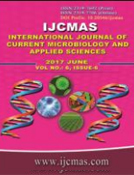


 National Academy of Agricultural Sciences (NAAS)
National Academy of Agricultural Sciences (NAAS)

|
PRINT ISSN : 2319-7692
Online ISSN : 2319-7706 Issues : 12 per year Publisher : Excellent Publishers Email : editorijcmas@gmail.com / submit@ijcmas.com Editor-in-chief: Dr.M.Prakash Index Copernicus ICV 2018: 95.39 NAAS RATING 2020: 5.38 |
Blast of rice (Oryza sativae L.) caused by Pyricularia oryzae is one of the most destructive disease in Manipur giving losses ranging from 60 to 100%. In the present investigation, biocontrol of this disease was attempted by isolating local strains of Pseudomonas fluorescens and Trichoderma spp. P. fluorescens B 24 gave maximum mycellial inhibition (77.5%) among the bacterial biocontrol and T. koningiopsis T 162 gave maximum inhibition of 46.25%. Seed germination, root and shoot length were enhanced by single treatment (B 24) in vitro conditions. Plant height was also increased by 5% in greenhouse and 12.02% in field trial with single application (B 24). However, greenhouse and field data revealed significant reduction in Blast incidence (5.1% and 3.4%), lesion number (35.53% and 58.72%) and size (18.86%, 16.39%) when applied in consortia (B 24+ T 162) as compared to single application (B 24) resulting in incidence of 6.7% and 3.92%, lesion number of 33.33% and 14.67%, size of 15.09% and 27.83% irrespective of greenhouse and field trial. The results indicated the effectiveness of combined application of P. fluorescens B 24 and T. koningiopsis T 162 for plant growth promotion and control of Blast of rice and therefore can be integrated for managing Blast of rice.
 |
 |
 |
 |
 |